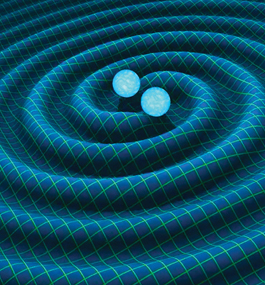On the Crest of a Gravitational Wave

R. Hurt / Caltech-JPL / NASA
SPIRALING: Artist’s rendering of gravitational waves generated by binary neutron stars.
by Lawrence Goodman
Some 130 million years ago, in a nearby galaxy, two neutron stars collided. The cataclysmic crash produced gravitational waves, ripples in the fabric of space-time that traveled across the universe.
On Aug. 17, Marcelle Soares-Santos, assistant professor of physics, along with hundreds of her colleagues, detected light from the event that generated the gravitational waves.
Gravitational waves have been long theorized — they underlay a 1916 theory proposed by Albert Einstein — but their existence was never certain until several years ago, when Laser Interferometer Gravitational-Wave Observatory (LIGO) scientists reported they’d discovered gravitational waves produced by the merger of two black holes.
The waves picked up in August by researchers at LIGO and Virgo, the umbrella organizations overseeing the worldwide search for gravitational waves, were from neutron stars, not black holes. Signals for black hole gravitational waves usually last less than a second, while those from neutron stars persist for as long as a minute, providing reams more data. Also, the black hole research from a few years ago involved recording the vibrations gravitational waves cause as they distort space-time (which sound like a series of small thumps).
But this time around, in addition to recording vibrations, Soares-Santos and her colleagues at the Cerro Tololo Inter-American Observatory, in northern Chile, captured the waves’ optical signal. An image yields far more precise information than a sound recording.
“The optical signal lets us do the equivalent of actually going there and looking at the neutron star merger,” Soares-Santos says.
Physicists predict that analyzing gravitational waves will offer answers to some of the biggest mysteries in cosmology, ushering in a new era of scientific discovery.
In the short term, scientists will gain new insights into neutron stars, which occur when giant stars 10 to 30 times as big as the sun collapse into objects about the size of the Greater Boston metropolitan area. Over the long term, gravitational waves may explain the universe’s continued expansion and the composition of dark energy, a mysterious substance that makes up roughly 70 percent of the universe.
“This is a whole new window into the universe,” Soares-Santos says. “This is beyond my wildest dreams.”
Soares-Santos arrived at Brandeis last year after working for more than a decade at the Fermi National Accelerator Laboratory, part of the U.S. Department of Energy.
Each winter, she goes to the observatory in Chile to do research. “It’s really fun and exciting to be up there,” she says. “There’s a control room with several computers, and you can see the raw images of space as they come in. In 2012, when we started and first saw starlight, it was one of the most exciting times in my life.”
She joined Brandeis because the university offered her the opportunity to have her own research group, which she hopes to develop into a leading force in the fields of cosmology and astrophysics.
Soares-Santos’ interest in physics started early, when she was 4, living in a small town called Carajás in Brazil’s Amazon rain forest. She happened to witness, from a distance, an explosion at the iron-ore mine where her father worked.
“It was so amazing because I could see it, but it took a few seconds before I heard anything,” she says. “Someone told me that light travels faster than the speed of sound. It was mind-blowing. I knew I wanted to learn more.”
